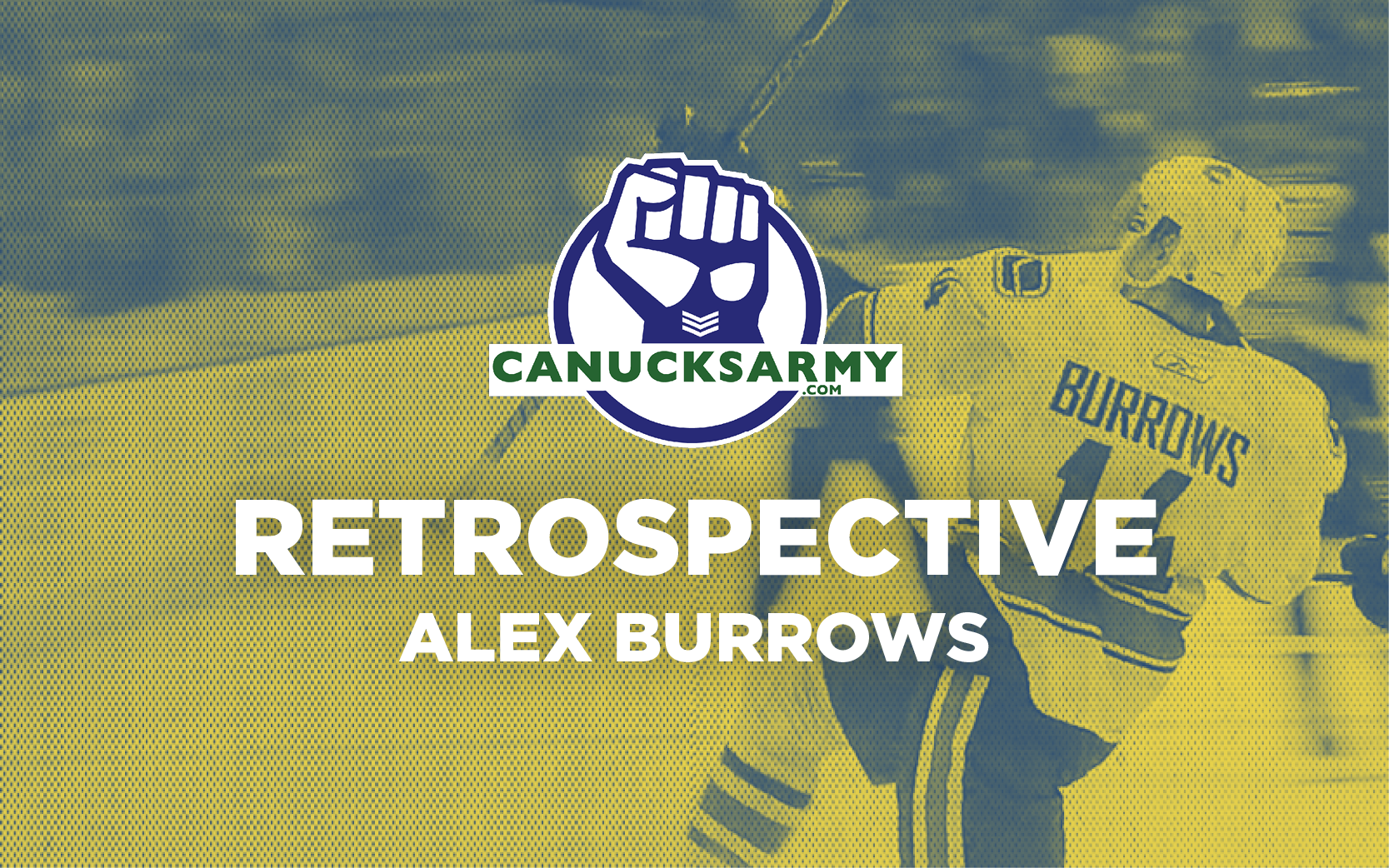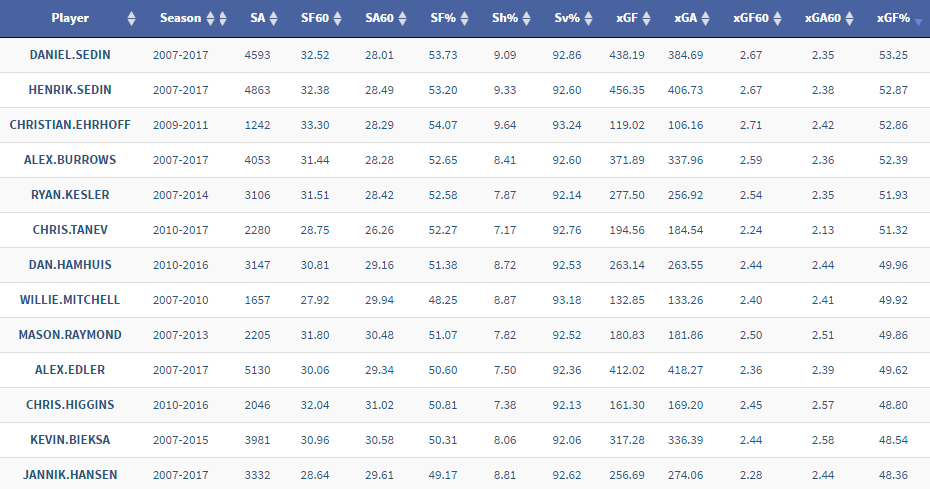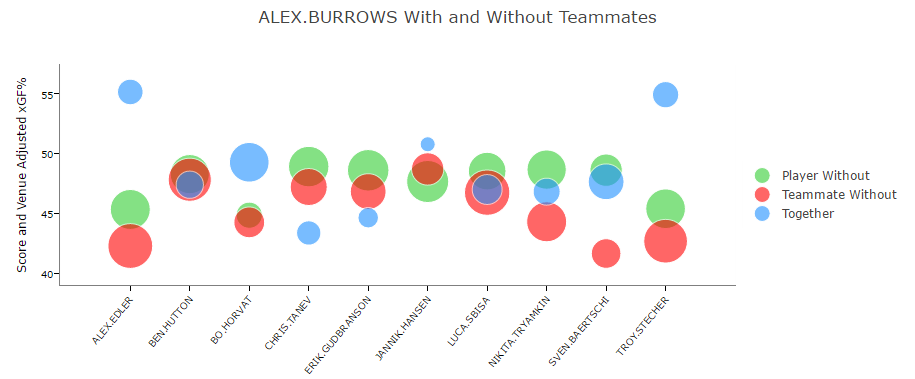Saying Goodbye To Alex Burrows, The Most Underrated And Controversial Player In Canucks History

7 years ago
The Canucks pulled off a heist last week when they acquired Jonathan Dahlen from the Ottawa Senators in exchange for Alex Burrows. The benefits of that transaction for the Canucks have been discussed ad nauseam across the blogosphere since then, which will likely continue for the forseeable future. Alex Burrows, on the other hand, has yet to receive a proper send-off from this particular corner of the internet. So, today we look back on Alex Burrows, and his unforgettable tenure with the Vancouver Canucks.
THE PLAYER
Burrows has been one of Vancouver’s single most productive players of the past decade, finishing his time as a Canuck with 383 points in 822 games, cracking the top-ten players in franchise history in both goals (9th) and games played (6th). He’s also amassed a spreadsheet resume that’s endeared him to countless statheads across the smylosphere, carrying one of the highest percentages of shot shares and expected goals among Canucks’ players in the behind the net era. That’s an incredible accomplishment for a player that’s been in the lineup for almost twelve seasons and bounced up and down the depth chart as much as Burrows has.

From 2008 to 2012, his most prolific years as a point producer, Burrows amassed four consecutive seasons with more than 25 goals, including a career high of 35 in 2009-10, in which he led the team in that category. Burrows also spent the bulk of his most productive era in Vancouver making just $2 million a year, making him one of the league’s most cost-effective goal scorers.
While it’s undeniable that Burrows benefited greatly from playing alongside Henrik and Daniel Sedin during the prime of their career, it’s also worth noting that no player has ever reached loftier goal totals in a season spent playing on their right side. The Sedin twins have spent the majority of their careers elevating players beyond what could reasonably be expected of them, but in Burrows, they found a true complimentary player whose speed, versatility, two-way play, dogged forechecking, and nose for the net made the whole greater than the sum of it’s parts. Burrows is, perhaps, the only winger the Sedins have had that we can truly say that about.
More recently, Burrows cemented his reputation in Vancouver by transitioning into a role as a useful two-way middle-six winger, first alongside Chris Higgins and Nick Bonino and more recently with Bo Horvat and Sven Baertschi. While his play has undoubtedly declined in recent years, he’s generally had a positive impact on his linemates’ ability to drive play, with most of his common linemates seeing an uptick in xGF% when on the ice with him:

Burrows may not be worth the two-year, $5 million extension he signed with the Senators, it’s undeniable that he will help their cause in the near future. In four games with the Senators, Burrows has three goals and one assist, and shows no signs of slowing down.
It’s clear the Canucks came away as winners in the deal for prospect Jonathan Dahlen, but the reaction to the trade by Senators fans and statheads has been, like most thing that involve Alex Burrows, over-the-top. For him to be categorized as a player that’s no longer of NHL-calibre, the way he was by SB Nation’s Ottawa Senators blog Silver Seven last week, is patently ridiculous. Burrows has been and should continue to be a useful middle-six winger. While Dahlen may prove to be the better player down the road, Burrows will improve the middle of the Sens’ roster in the short-term.
THE PERSON
The long and unconventional development path Alex Burrows took to get to where he stands today is something that’s been heavily overshadowed by the highs and lows of his NHL career. In fact, Alex Burrows has played the heel so well over the past ten years or so that many hockey fans forget or are unaware that Burrows’ career has been a testament to rewards of dedication and perseverance, becoming one of the most prolific former AA players in NHL history.
Burrows went undrafted after two seasons in the QMJHL, and took his talents to the ECHL, where he would continue to play on and off for three seasons. During this period, he was more notable for his achievements in ball hockey than he was for his professional career, winning six straight national championships as well as two for Canada’s international ball hockey team, as well as leading those tournaments in scoring on multiple occasions.
In his second ECHL season, Burrows found a home with the Columbia Inferno, and potted a career-high 73 points. His play earned him a contract with the Inferno’s AHL affiliate, the Manitoba Moose, where he would carve out a fourth-line role during the 2004-05 season. The following year, Burrows would earn a two-way contract with the Canucks, where he would work his way up from fourth-line PK specialist to eventually being placed at right wing with Henrik and Daniel Sedin on February 12th, 2009. All told, it took Alexandre Burrows six and a half years to go from undrafted ball hockey player to one-third of one of the NHL’s best lines of the past decade.
Off the ice, he was notable for his numerous contributions to Canucks For Kids, the Make-A-Wish Foundation, and the BC Children’s hospital, as well as serving as the Canucks’ most recent spokesperson for Mindcheck.ca, a project that aims to end the stigma of mental illness and connect youth with mental health services and support.
In Vancouver, he’ll forever be associated with the memory of close friend Luc Bourdon, who died in a tragic motorcycle accident in 2008 at the age of 21. Since Bourdon’s death, Burrows has been known to celebrate big goals by miming a bow-and-arrow as a tribute to Bourdon, who used it as his signature celebration throughout his junior career.
THE PEST
It would be remiss of anyone chronicling Burrows’ time in Vancouver to ignore the considerable amount of controversy he’s courted over his pro career. It’s been said countless times across this market that Burrows is a player who “played on the edge”, but the truth is, he didn’t just play on that edge, he also crossed it on multiple occasions. Burrows has a rap sheet long enough to stretch across the Lower Mainland for infractions that range from biting and hair-pulling to publicly criticizing an NHL official.
His well-earned reputation as an agitator makes Burrows a tough player to defend at times, but context is key. The coverage regarding Burrows’ numerous transgressions as a player have been bizarrely one-sided at best and painfully hypocritical at worst.
Is biting and hair-pulling acceptable behaviour? Of course not. But at the same time, the question of why Patrice Bergeron’s hand was in Burrows’ mouth to begin with is never discussed. By the same token, Duncan Keith’s fishhook on Burrows in the same play from which the hair-pulling controversy emerged is usually omitted whenever the incident is recalled.
In the eyes of many, his worst infraction may have been the inappropriate comments he directed at Patrick O’Sullivan regarding the latter’s abuse at the hands of his father, John. Burrows was apologetic when the press broached the subject, but that’s cold comfort to anyone who has actually suffered in the manner O’Sullivan did. While hours could be spent on the irony of O’Sullivan’s status as a spokesperson for anti-bullying in the NHL given the way he conducts himself on Twitter, the fact remains that Burrows comments were inexcusable. Judging by O’Sullivan’s recollection of the incident, they were also made roughly 8-10 years ago, but only came to light after O’Sullivan’s piece in the Player’s Tribune. The relevance of that nugget of information may be debatable, but again, it’s context that’s notably absent from any discussion regarding Burrows’ character.
For all the admittedly crass behaviour he’s exhibited at times throughout his career, the incident that’s probably had the deepest impact on his career was also his most benign: the public call-out of former NHL official Stéphane Auger. By Burrows’ account of the story, Auger was upset about a play he had embellished in a prior game, and allegedly told Burrows prior to a game against the Nashville Predators on January 11th, 2010,
“you made me look bad [for calling the Smithson penalty] so I’m going to get you back tonight.”
Auger would later go on to call a questionable interference penalty on Burrows that would cost the Canucks the game.
The incident caused a media firestorm from which Burrows’ image would never recover. (Athough his behaviour certainly didn’t help things, either.) Later that week, Ron MacLean, host of CBC’s Hockey Night In Canada, in a segment that featured then-NHL vice president Colin Campbell, devoted 11 uninterrupted minutes of the broadcast to Burrows’ history of embellishment, which was not only wildly unprofessional but also completely irrelevant to Burrows’ allegations. The Canucks responded in kind by refusing to be interviewed before, during, and after their next game to be broadcast on CBC. While the two organizations would later publicly bury the hatchet, the damage was done, and Burrows was forever a marked man.
That leads us to a subject that’s rarely broached when discussing Burrows’ prior transgressions: the seemingly arbitrary manner in which the NHL, it’s fans, and the media categorizes on and off-ice behaviour. For a game that’s spent the majority of the past century singing the praises of face-washing and bare-knuckle boxing to turn it’s nose up when a player uses his hands, stick, or teeth in an unbecoming fashion is, frankly, hypocritical. To the best of my knowledge, no major sports’ network has ever aired an eleven minute exposé on the potentially life-threatening plays made by Marty McSorley, Todd Bertuzzi, or Shawn Thornton, nor has any network consulted with an NHL Vice President on the numerous incidents of off-ice physical and sexual assault by it’s players.
In other words, you can hate Alex Burrows as much as you want, but he pales in comparison to the Bobby Hulls, Slava Voynovs, and Mike Ribeiros of the world. While Burrows has certainly courted his fair share of controversy over the years, and rightfully so, he’s a grade-A pest that’s been miscast as one of the league’s greatest villains. The NHL has seen far worse.
SAYING GOODBYE
Canucks fans will undoubtedly remember Burrows first and foremost as a player that’s scored some of the team’s most iconic goals, from breaking the streak, to his overtime goal in Game One of the Stanley Cup Final, to possibly the most significant goal in franchise history: his overtime game winner in Game Seven against the Chicago Blackhawks.
To others, he’ll be remembered as possibly the greatest Cinderella story in the history of the NHL, going from depth ECHLer to bona-fide top line forward.
And, to fans outside Vancouver, he’ll go down as one of the most hated players in recent memory. Unfortunately for Burrows, that’s his cross to bear. His two greatest demons will always be his questionable past, and his inability to hoist the Stanley Cup.
Let’s not count that out just yet, though. It’s a beautiful day for an exorcism.





